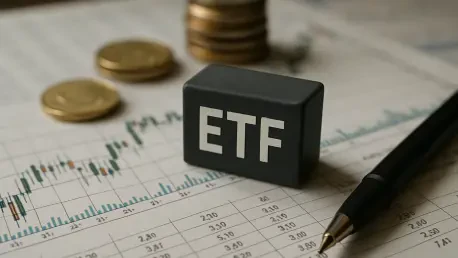In today’s unpredictable economic landscape, where market volatility is fueled by shifting trade policies, labor market concerns, and fluctuating interest rates, investors are increasingly seeking reliable avenues for consistent returns. Dividend exchange-traded funds (ETFs) have emerged as a compelling solution, offering a blend of stability and income that can weather turbulent times. These funds, often tied to companies with strong track records of dividend payments, provide a buffer against uncertainty by delivering regular payouts while mitigating some of the risks associated with capital losses. As economic slowdowns loom and policy decisions create ripples across financial markets, the appeal of dividend ETFs lies in their ability to cater to income-focused portfolios. This article delves into the reasons behind their growing popularity, exploring how macroeconomic challenges, the unique strengths of dividend-paying assets, and specific ETF options make them a cornerstone for steady income.
Navigating Economic Challenges with Dividend ETFs
Amid the current economic climate, characterized by concerns over job market stability and broader slowdowns, investors face heightened uncertainty that demands a cautious approach. Trade policy fluctuations and potential tariff impacts have added layers of complexity, prompting a search for investments that can offer predictability. Dividend ETFs stand out in this context as they often invest in established companies with a history of resilience. These funds provide a steady income stream that can help offset the volatility seen in other asset classes. Moreover, with the Federal Reserve contemplating interest rate adjustments to address labor market weaknesses, the environment could become more favorable for dividend-paying stocks. Lower rates typically drive demand for higher-yielding assets, positioning dividend ETFs as a strategic choice for those looking to maintain cash flow during unpredictable times. This dynamic underscores why such funds are gaining traction among risk-averse investors.
The broader economic backdrop also highlights the protective nature of dividend ETFs as a hedge against downturns. Unlike growth stocks that may falter in a slowing economy, dividend-focused investments often belong to mature industries with less exposure to sharp market swings. These sectors tend to prioritize consistent payouts, ensuring that investors receive regular income regardless of short-term market fluctuations. Additionally, the possibility of short-term inflation spikes due to policy changes like tariffs makes the fixed income from dividends even more appealing. By focusing on companies with strong fundamentals, such as robust cash flows and solid balance sheets, dividend ETFs offer a layer of downside protection. This stability is particularly valuable when traditional income sources, like bonds, may underperform in a low-rate environment, pushing investors toward equities that can deliver both income and relative safety.
The Strength of Dividend Aristocrats in ETFs
One of the key attractions of dividend ETFs is their frequent inclusion of dividend aristocrats—blue-chip companies that have consistently increased payouts for decades. These firms are often seen as bastions of stability, hailing from sectors with sustainable business models and proven profitability. Their long track record of dividend growth signals not just past reliability but also the potential for future increases, making them a cornerstone of income-focused portfolios. Within ETFs, these aristocrats provide diversified exposure that reduces the risk tied to any single company’s performance. Investors benefit from a curated selection of such stocks, ensuring that their capital is allocated to entities with strong financial health. This approach is particularly effective in uncertain times, as it balances the need for income with the imperative of capital preservation.
Beyond their historical performance, dividend aristocrats within ETFs offer a unique advantage through their ability to weather economic storms. These companies typically operate in less cyclical industries, meaning their earnings—and by extension, their dividends—are less susceptible to economic downturns. This characteristic provides a cushion for investors when market sentiment turns bearish. Furthermore, the high yields associated with these stocks can help mitigate potential capital losses, ensuring that total returns remain positive even in challenging conditions. Dividend ETFs that target such aristocrats often come with the added benefit of diversification across multiple sectors, further spreading risk. For those prioritizing long-term income over speculative gains, this combination of reliability and yield makes these funds an indispensable tool in navigating financial uncertainty with confidence.
High-Yield ETFs as a Strategic Income Solution
In a low-interest-rate environment, high-dividend ETFs present an attractive alternative for income seekers who might otherwise struggle with diminished returns from fixed-income assets. These funds focus on stocks that offer above-average yields, ensuring that investors receive substantial payouts that can supplement other income sources. The appeal of high yields becomes even more pronounced when central banks signal potential rate cuts, as the relative value of dividend income rises compared to bonds or savings accounts. By pooling a variety of high-yield stocks, ETFs in this category provide a diversified approach that minimizes the impact of underperformance by any single holding. This structure is particularly beneficial for those aiming to maintain a steady cash flow without taking on excessive risk in volatile markets.
The versatility of high-yield dividend ETFs also lies in their adaptability to varying investor needs, catering to both conservative and moderately aggressive strategies. Some funds emphasize maximum yield, targeting companies with the highest payouts, while others balance yield with growth potential to ensure sustainability. This range of options allows investors to align their portfolios with specific financial goals, whether seeking immediate income or building wealth over time. Additionally, the consistent income from high yields can act as a buffer against inflation, preserving purchasing power when prices rise due to policy-driven economic shifts. As a result, these ETFs are not just a temporary fix but a perennial favorite, offering a practical solution for income stability across different market conditions. Their role in providing financial security remains critical for anyone looking to navigate uncertainty.
Exploring Specific Dividend ETF Options for Investors
For those ready to incorporate dividend ETFs into their portfolios, several standout options cater to diverse preferences for yield, growth, and cost. The Vanguard Dividend Appreciation ETF (VIG), with a low expense ratio of 5 basis points, targets companies with a history of increasing dividends, making it ideal for growth-oriented income seekers. Similarly, the SPDR S&P Dividend ETF (SDY), charging 35 basis points, focuses on high-yield dividend aristocrats with at least 20 years of consistent growth, appealing to those prioritizing stability. The Vanguard High Dividend Yield ETF (VYM), with a fee of 6 basis points and a yield of 2.61% annually, offers above-average payouts for higher income needs. Lastly, the First Trust Rising Dividend Achievers ETF (RDVY), at 48 basis points and a yield of 1.42%, balances dividend history with potential growth. These choices provide a spectrum of strategies for building a resilient income stream.
Delving deeper into the benefits of these ETFs, their low-cost structures and diversified holdings stand out as key advantages for long-term investors. Funds like VIG and VYM keep expenses minimal, ensuring that more of the returns reach shareholders rather than being eroded by fees. Meanwhile, SDY’s focus on long-term dividend growers offers a safeguard against market volatility, as these companies are less likely to cut payouts during downturns. RDVY, on the other hand, introduces an element of growth by targeting rising dividend payers, which can enhance total returns over time. Each of these ETFs addresses different aspects of income investing, from maximizing current yield to ensuring future dividend increases. By carefully selecting among these options, investors can tailor their portfolios to match risk tolerance and financial objectives, securing steady income even amid economic fluctuations.
Building Resilience Through Dividend Strategies
Reflecting on the economic challenges that have shaped investment landscapes in recent times, dividend ETFs have proven to be a reliable anchor for many portfolios. Their ability to deliver consistent income while offering protection against volatility has helped countless investors navigate periods of uncertainty with greater confidence. Looking ahead, the focus should shift to integrating these funds into broader financial plans, ensuring alignment with individual goals and risk profiles. Exploring a mix of high-yield and growth-oriented ETFs can create a balanced approach that adapts to changing market conditions. Additionally, staying informed about policy shifts and interest rate trends will be crucial for optimizing the benefits of dividend investments. By prioritizing fundamentally strong companies and diversified funds, investors can continue to build resilience, turning economic challenges into opportunities for sustained financial stability.









